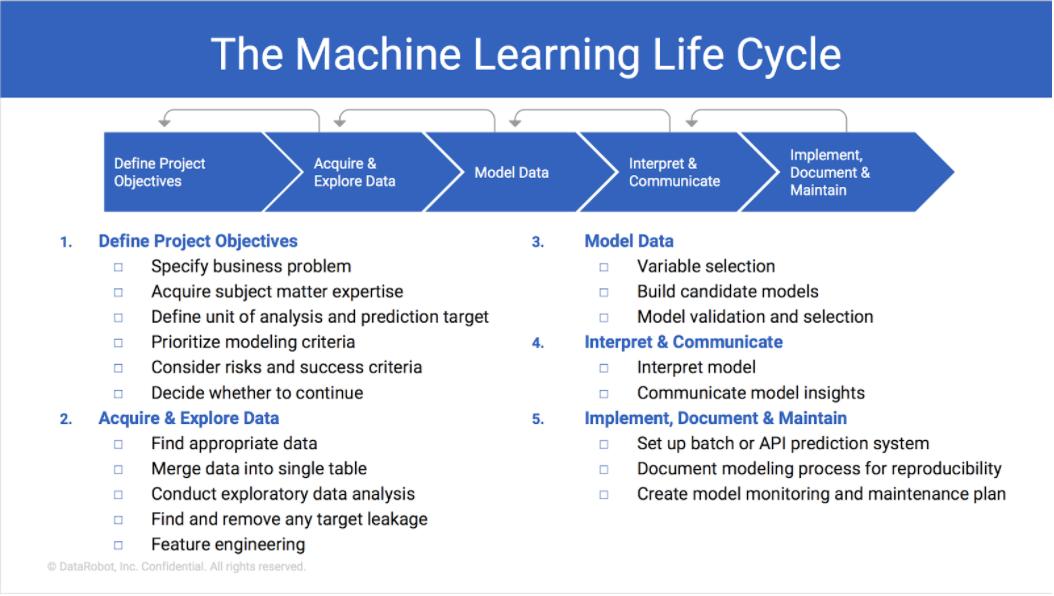Machine Learning Life Cycle
What is the Machine Learning Life Cycle?
The machine learning life cycle is the cyclical process that data science projects follow. It defines each step that an organization should follow to take advantage of machine learning and artificial intelligence (AI) to derive practical business value.
There are five major steps in the machine learning life cycle, all of which have equal importance and go in a specific order.

Machine Learning Life Cycle Example
Here is a step-by-step example of how a hospital might use machine learning to improve both patient outcomes and ROI:
- Define Project Objectives: The first step of the life cycle is to identify an opportunity to tangibly improve operations, increase customer satisfaction, or otherwise create value.In the medical industry, discharged patients sometimes develop conditions that necessitate their return to the hospital. In addition to being dangerous and troublesome for the patient, these readmissions mean the hospital will spend additional time and resources to treat patients for the second time.Not only that, hospitals are fined if patients are readmitted within 30 days of their release. To avoid these fines and to prevent patients from spending extra time confined to a hospital bed or suffering potentially life-threatening relapses, the hospital wants to use patient data to understand which factors lead to a high probability of future complications in order to take preventative action.
- Acquire and Explore Data: The next step is to collect and prepare all of the relevant data for use in machine learning. This means consulting medical domain experts to determine what data might be relevant in predicting readmission rates, gathering that data from historical patient records, and getting it into a format suitable for analysis, most likely into a flat file format such as a .csv.
- Model Data: In order to gain insights from your data with machine learning, you must determine your target variable, the factor on which you wish to gain deeper understanding. In this case, the hospital will choose “readmitted,” which it included as a feature in its historical dataset during data collection. The hospital will then run machine learning algorithms on the dataset to build models that learn by example from the historical data. Finally, the hospital runs the trained models on data to which the model has not been trained on to forecast whether new patients are likely to be readmitted, allowing it to make better patient care decisions.
- Interpret and Communicate: One of the most difficult tasks of machine learning projects is explaining a model’s outcomes to those without any data science background, particularly in highly regulated industries such as healthcare. Traditionally, machine learning has been thought of as a “black box” because it is difficult to interpret insights and communicate the value of those insights to stakeholders and regulatory bodies. The more interpretable your model, the easier it will be to meet regulatory requirements and communicate its value to management and other key stakeholders.
- Implement, Document, and Maintain: The final step is to implement, document, and maintain the data science project so that the hospital can continue to leverage and improve upon its models. Model deployment often poses a problem because of the coding and data science experience it requires and because the time-to-implementation from the beginning of the cycle using traditional data science methods is prohibitively long.
Why is the Machine Learning Life Cycle Important?
The machine learning life cycle is important because it delineates the role of every person in a company in data science initiatives, ranging from business to engineering personnel. It takes each and every project from inception to completion and gives a high-level perspective of how an entire data science project should be structured in order to result in real, practical business value. Failing to accurately execute on any one of these steps will result in misleading insights or models with no practical value.
The Machine Learning Life Cycle + DataRobot
The DataRobot AI Platform streamlines the machine learning life cycle by simplifying and automating the most complicated, time-consuming steps. It makes data exploration and model building easier and more accessible, allowing those who understand the business problem behind the data science project to rapidly build and test dozens of models in a fraction of the time it would take using traditional methods. Additionally, DataRobot includes built-in tools, including its unique Prediction Explanations feature, that increase model interpretability, making it easier to communicate the value of machine learning to users throughout your organization.
Not only that, DataRobot offers resources to help you and your organization obtain a deeper understanding of the machine learning life cycle. By attending DataRobot University, you can learn how to execute machine learning projects from beginning to end.




